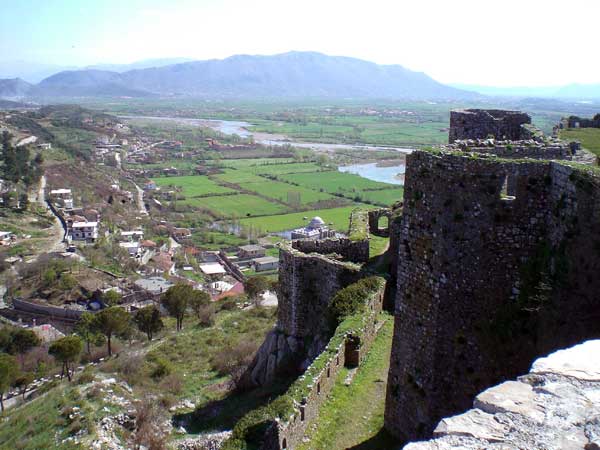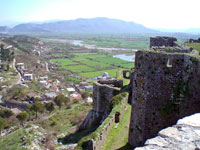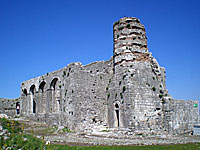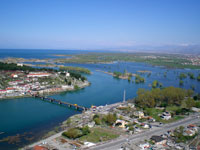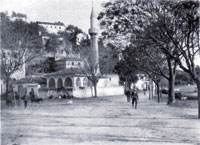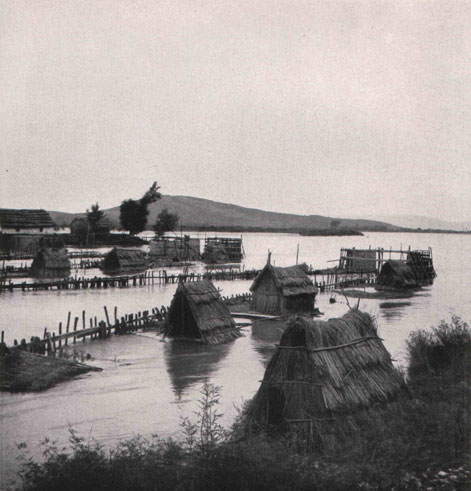| | Robert Elsie | AL Art | AL History | AL Language | AL Literature | AL Photography | Contact | |
Robert Elsie
Texts and Documents of Albanian History
BACK | AL History
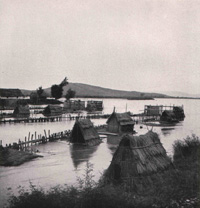
Fish weirs on the Buna River
near Shkodra, 1942
(Photo: Erich von Luckwald).
1662
Evliya Chelebi:
Seyahatname
- a Journey through Northern Albania
and Montenegro
The Ottoman Turkish writer Evliya Chelebi or Çelebi (1611-1684) travelled extensively through the Ottoman empire and neighbouring countries from 1640 to 1676, both in a private capacity and at the service of the Sublime Porte. The account of his travels is recorded in his ten-volume Turkish-language Seyahatname (travel book), which he completed in Cairo. The Seyahatname contains a wealth of information on the cultural history, folklore and geography of the countries he visited. In 1662, Chelebi travelled through northern Albania and Montenegro where he was sent by his patron Melek Ahmed Pasha in Belgrade to collect some debts. On this trip, he journeyed through central Albania to Tirana, Lezha, Shkodra, Bushat, Podgorica, Budva and Ulcinj before proceeding through the mountains to Gjakova in Kosova, and on to Sofia, where he was reunited with his patron.
From here [Mileševa] we crossed the high mountain pastures of Krraba (1) with great difficulty and in 9 hours arrived at the town of Tirana. It is administered by a voyvoda in the sandjak of Ohrid and has a kadi with a salary level of 150 akçe. The town is situated on a broad plain and has mosques, hans, bathhouses, bazaars, vineyards and gardens. All the public buildings have fully tiled roofs and are splendid structures. .....
From here we crossed the Mati river on horseback. This river descends from Omoras (?) mountains and flows into Lake Ohrid. (2)
From here we continued in a westward direction and arrived at the village of Omoras, (3) also in the territory of Ohrid. It is a prosperous village the size of a town, with 300 houses, a mosque, a han and a bathhouse, and surrounded by vineyards and gardens. The rayah (i.e. the peasants in the surrounding countryside) are all infidels and their women folk are all enchantresses.
From here we proceeded for 9 hours to the ancient fortress of Lezha. (4) In Albanian, it is called Les (Lezhë). Sultan Mehmed the Conqueror took over Lezha from the Venetians with difficulty in 883 (1478) when he was advancing on Shkodra. "This fortress is like a lion (leys)," he remarked, and after the battle it was called Lion Fortress (Kale-yi Leys), but gradually Leys ('Lion') became corrupted to Les ('Corpse'). According to the Conqueror's survey register, it is part of the sandjak of Dukagjin in the eyalet of Rumelia and is administered by a voyvoda. It has a market inspector, a deputy kadi, a collector of tolls and a castle warden with ..... garrison soldiers.
The square-shaped fortress of Lezha is situated on a promontory over the banks of the Drin. Its small ramparts were skilfully fashioned, but they are not in good repair, even though the fortress is on the frontier of the Venetian Franks. It was originally constructed by the doges of Venice.
All the Albanian ghazis from this town cross the sea on their frigates and maraud in Venetian territory and along the coast of Spanish Puglia. They then return with their booty and their infidel captives, alive or dead, to the fortress of Lezha where they throw the corpses into the Drin river. The fortress is at a distance of ..... from the Adriatic Sea. After emerging from the ..... mountains, the Drin continues southwards and flows into the sea near the port of Shëngjin.
Lezha has ..... prayer-niches, ..... medreses, ..... tekkes, ..... schools, ..... hans, ..... bathhouses and ..... shops. It has a total of 4 (?) frontier houses with tiled roofs surrounded by vineyards and gardens. Inside the fortress there are very few houses and no gardens, but there are many ammunition depots as well as magnificent long-range battering guns and a military band.
From here we set off westwards, crossing the Drin river, and journeyed to the walled city of Shkodra. It was founded by Iskender Zu'l-qarneyn (Alexander the Great) and was thus called Iskenderiyye (5) (Alexander). It was subsequently taken over and enlarged by Spain, then passed from the king of Puglia into the hands of the doges of Venice. When Mehmed the Conqueror received the dreadful news that the Venetians had begun to loot and plunder the lands around Skopje, Prishtina and Vushtrria, he resolved at once to pacify the region and, arriving with a huge expeditionary force, he conquered the fortress from the Venetians in the year 883 (1478) after a siege of forty days and forty nights. He then made it the capital of a separate sandjak in the eyalet of Rumelia, (33b) bestowing it as a hereditary fief (ocaklik) upon Yusuf Bey, the first sandjak bey of Shkodra. And so, its rulers are still known as Yusuf Beg Ogullari.
The present governor, Mehmed Pasha, came out to meet us and accompanied us into the fortress where we were quartered in the house of the castle warden, ..... Aga. When Mehmed Pasha had read the affectionate letters which I gave him from Melek Pasha, he expressed delight. "God willing," he cried, "I shall meet my obligations and repay my debt within ten days, and you may continue your journey." He gave me a purse of kuru? for bath-expenses and a set of clothing, and gave my thirty companions and servants ten kuru? each. We frequently resorted to the Yusuf-Bey-Zade palace in a village called Bushat, where we were well received and had an excellent time. But we always returned to Shkodra because the Venetian infidels were up in arms.
There are three Iskenderuns or Alexandrias in the Ottoman Empire. One is this Albanian Iskenderiyye (Shkodra). The second, called Iskenderun, is on the shore of the Mediterranean, one caravan stage from Aleppo, and serves at the port for that city. (6) The third is Alexandria in Egypt, which in Greek is called Alexandria Pyrgos, or Alexander's Castle.
According to the statute of Suleyman Khan, the bey possesses an imperial grant worth 459,200 akçe, plus 19 zeamets and 205 timars, and for every 3,000 akçe he must provide one armed retainer (celebü). These, together with the troops of the alay-bey, the çeribasi, the subasi, and the pasha himself, provide a force of 4,000 select armoured soldiers. In time of war, this force is put under the command of the vizier or otherwise the sandjak beys of Rumelia. And indeed, all of these brave ghazis were with us during the Transylvania campaigns.
The sandjak also provides 40 purses for the pasha who, with the help of 1,000 warriors under his command, guards and defends the sandjak. Among the ser'i authorities in Shkodra are the grand mufti (seyhülislam), the nakibülesraf along with various notables and descendants of the Prophet, the kadi with a salary level of 150 akçe, the steward of the sipahis, the commander of the janissaries, the castle warden along with the garrison soldiers, the market inspector, the voyvoda, the collector of tolls, the chief engineer, the mayor (sehir kethüdasi) and the poll-tax official.
Plan of the fortress of Shkodra. It is situated upon a lofty and very steep cliff overlooking a great lake called Boyana. (7) It is square-shaped, somewhat slanted. The fortress is constructed of chiselled stonework and is fully functional, with no obstructing higher ground in the vicinity. Though small, it is strong and impregnable. It has no moat on the lake side or on any other side, but does have many towers and crenellated battlements. There are two gates, one facing east, the other overlooking Küçük Ova (Small Plain). Inside this second gateway is the shrine of Muyo Baba Sultan. Within the fortress there are few houses and only one congregational mosque, i.e. the radiant mosque of Sultan Mehmed, covered in tiles and constructed in the old style. There are 7 or 8 cisterns which fill up with rain water. Descending from the fortress to Lake Boyana are water channels known only to those in the fortress. They cannot be seen by the enemy outside. It is through these channels that they fetch water during sieges. There are no shops inside the fortress, only 100 houses for the garrison soldiers and storage bins for wheat. There are also ammunition depots and fine imperial cannons. It might be possible for an enemy to bombard the fortress from Mount Tarabosh, which looms above on the other side of Lake Boyana, but they would need cannons forty spans in length. Smaller guns pose no threat, because the lake is in between. At the foot of the fortress, near the cliffs down at the lake, there are fish weirs built on pinewood pilings. These weirs are administered on commission from the fortress garrison. .....
The open town (varos) of the fortress of Shkodra. The town outside the walls consists of 1,800 one- and two-storey stonework houses with slate and tiled roofs and surrounded by vineyards and gardens. The inhabitants are all Muslim. There are 15 quarters, of which the best known are: Bayazid Khan quarter, Ali Bey quarter, Hüsein Bey quarter, Iskele-basi (Docks) quarter, Mufti quarter, Kara Hasan quarter and the Courthouse quarter at the end of the bazaar .....
Mosques of the monotheists. There are 11 prayer-niches (i.e. congregational mosques). First is the mosque of Sultan Bayazid II the Saint at the end of the bazaar. In front of it is a well with delicious water and an iron chain. It is definitely the finest of the mosques, an exquisite building with a tiled roof, and has a large congregation. Then comes the mosque of Hüseyn Bey in the Ali Bey quarter, the Mufti mosque at the Docks; and the mosque of Kara Hasan. These are all well-known and radiant mosques with tiled roofs. Aside from these, there are 70 other prayer-houses. .....
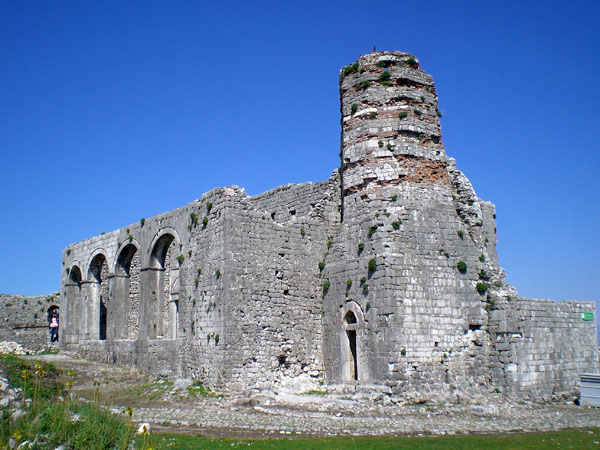
There are 7 medreses, each congregational mosque having its own, but there are no special schools of Koran recitation or Hadith. There are ..... primary schools, 6 dervish tekkes, and ..... hans, of which the Ulama Pasha han is the strongest in construction and the most imposing, with all kinds of precious furnishings. There is a single very spacious and attractive bathhouse which gets its water from Lake Boyana by means of a waterwheel. There are 500 shops in the covered market, all the skills and handicrafts being represented. The fish-market at the lakeside is well-maintained and furnished.
Clothing of the manly men. They all wear broadcloth garments and tight buttoned trousers with a teybend silk waistband and kubadi shoes. On their heads, they wear Albanian calpacs made of sable. Both learned scholars (ulema) and rakish youths (levendât) alike carry kortela knives in their belts, and the youth are never to be seen without their swords and shields.
Clothing of the demure women. They all wear full-length broadcloth coats and a strange conical headpiece, like the caps worn by the imperial guards, and they wrap themselves in white muslin wraps. On their feet they wear soft yellow indoor boots and shoes. They go about very well-mannered.
Men's names. .....
Women's names. ....
Praise of the lovely boys and girls. They have silver limbs and rosy cheeks.
Praise of the salubrious climate. Because of the fine climate, all the people reach the age of seventy or eighty without diminution of their faculties.
Praise of the sparkling water-of-life. On the one side is the Drin river, like the water of Kevser, and on the other side is Lake Boyana, the water of which is like pure wine. (8)
Climes and latitudes of towns and countries. .....
The rising star of auspicious prosperity. .....
Churches of monks. .....
Cereals and plants. .....
Meats and foodstuffs. .....
Fruits. .....
Beverages. .....
Natural wonders. The hand of the Almighty Creator fashioned seven grassy islands of various sizes in the middle of the lake, no bigger than one or two or three or five threshing-floors. During some years, a violent storm arises and these little islands become dislodged and move to another part of the lake. Sometimes the islands even meet in the middle of the lake and join together. They each have a variety of shrubs and grassy plots. The townsfolk like to sail out to these little islands in their caiques for picnics. Sometimes a strong wind arises and one or two of the islands get dislodged and float from one end of the lake to the other, taking the people with them as though borne on the throne of King Solomon's audience-hall. The people delight in sailing about on the islands, and they boast about their exploits of years gone by. No one ever suffers any harm, for that is the nature of these islands - "God is capable of anything." It takes an extremely strong wind to dislodge the islands, or so it was reported. During the time that I was in Shkodra, there were quite a few storms, but I never saw those islands moving, though I did see them not moving. In my curiosity, I questioned the old people about the past, and they related the following:
"In the year [1031/1621], when Sultan Osman II advanced against Khotin, there was a severe winter storm which caused even the Bosphorus in Istanbul to freeze over. Here in Shkodra the storm blew down houses and uprooted large trees, whirling them in the air like falconer's lures. That year, these little islands in Lake Boyana floated about for forty or fifty days, from north to south and from east to west." This is what the old-timers told me.
Praise of the lake of Albanian Iskenderiyye (Lake Shkodra). The body of pure water at the foot of the fortress is known as Lake Boyana. It stretches lengthwise from east to west and is 11 miles in circumference. Mount Tarabosh, which looms up on the other side of the lake, is a cannon's range distance. It was from there that Mehmet the Conqueror bombarded the fortress. The other banks stretch lengthwise, forming a kind of fresh-water strait, with Mount Tarabosh at the mouth of it, where the water runs out of the lake. There is a delightful promenade at the end of the lake. From there a tributary flows westward for four hours until, after passing through vineyards and orchards, it empties into the sea. At the foot of the cliffs on which the fortress is built are 10 weirs for catching fish. These are state-owned; the income deriving from the fish caught in the weirs and in the lake is confiscated by the steward (emin) on behalf of the garrison of Shkodra fortress and goes to pay the salaries of the preachers and imams of the imperial (i.e. congregational) mosques in the city.
Many kinds of fish are caught in this lake, and in immense quantities. Plaice, carp, sea bass and mullet swim up the tributary from the sea into the lake. Eels are found in quantity and quality which outmatch those of the lakes of Kastoria, Ohrid and Besik. They are fat and have a musky scent that is particular to the eels of Lake Shkodra and not to be found elsewhere. Also, they are a marvellously beneficial fish. Anyone suffering from fevers and ailments can be cured by cooking and eating these eels, or merely by carrying eel-heads on their persons. Because of the presence of this type of musk-eel, the people of Shkodra suffer from no ills of any kind.
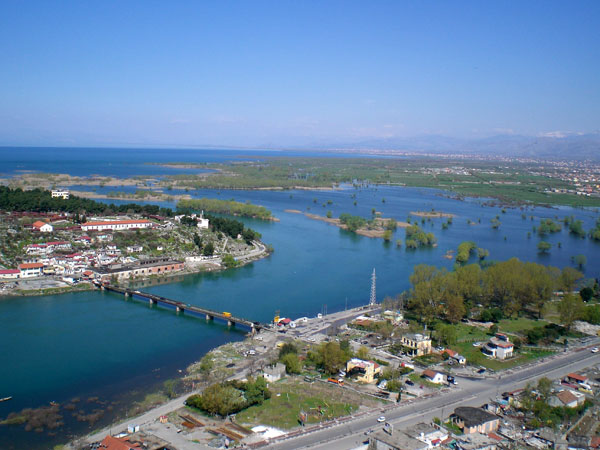
The pure water of this lake, when drunk regularly, brings about a loosening of the bowels and a cure for problems of the spleen and gall-bladder, and for phlegm, headaches, constipation, swellings and similar diseases. .....
Professions. There are fishermen, soldiers, merchants who trade on land and sea, handicraftsmen, scholars and ulema, and vintners for the 23,000 vineyards. This place is the home of brave and diligent Albanian ghazis, who, like Ferhad, earn their living by hard toil. (9) There are no other nationalities in this city.
[The language] They all speak Albanian, which is like no other tongue. In origin, the Albanians were one of the Arab tribes of Quraysh in Mecca. That is why there are some Arabic words still in use among them. When these Albanian tribesmen emerged from the mountains of Shkodra and Vlora, they mingled with the Italians and Franks, and so, during the caliphate of 'Omar (10) produced a language between Arabic and Frankish. We will give an account of the reasons for this and of the origin of the Albanians in another place. For now, it is called the language of Arnavud or in Persian, 'âr-nâ-bûd ("May there be no shame"), and certain chroniclers write it this way. It is a delightful language which they speak humbly and gently when they are addressing one another with respect. The infidels among them pass as Christians, although this, too, is at the insistence of the Spaniards and the Venetians. Otherwise, they are a company of scriptureless infidels and fornicators who, like the Zoroastrians, know nothing of the Book or of Judgment Day. Their language is as follows:
To start with, pörtuni zoti (11) means 'for God's sake'. When buying and selling, they count coins thus: ne 'one', dü 'two', tiri 'three', qotrá 'four', pensi 'five', gâst 'six', istat 'seven', teti 'eight', nandi 'nine', dit 'ten'. Falemi müre (12) 'greetings, men', aye sendos enbahi (13) 'hey, are you well?', mir nistira nise (14) 'good morning', miliserde (15) [welcome], palá mizuni (16) [thank you], buq 'bread', uy 'water', mis 'meat', dele 'sheep', puli 'hen', bayá müre (17) 'come, man', aha buq 'will you eat bread?', qu qiye 'where have you been?', miyalt 'honey', aqi te ki (18) 'is there barley?', nuku qám (19) 'there isn't', rus 'grapes', aqi mebe tesin qurd (20) 'bring barley or I'll split your head open', pörtuni zoti nuqu qám aqi (21) 'for God's sake, there is no barley', támu 'mother', motrá 'sister', soke 'wife'. The following are foolish expressions, but the traveller need to know them since he might be the object of cursing or a beating: hak mut (22) 'eat shit', tikifsati támu (23) 'I'll fuck your mother', tikifsati soke (24) 'I'll fuck your wife', ti piriste bihund (25) 'I'll fart in your nose', tikifsati büthi (26) 'I'll fuck your ass', iç qivirdim (27) 'catamite pimp'. In short, when dervishes are travelling, they should know such expressions as well, so that they can avoid trouble by not going to places where they will be abused.
Conclusion of the eulogy (sehrengiz) of Shkodra. In the open town, there are two bridges over the Drin river: the Hüseyn Bey bridge and the Ali Politina bridge. .....
Places of pilgrimage. Inside the fortress is the shrine of Muyo Baba, may his mystery be sanctified.
After touring this fortress and learning its ins and outs, we departed Shkodra with the sandjak-bey, Yusuf-Bey-Zade Mehmed Pasha, and travelled 2 hours north to the town of Bushat. (28) We entered this pretty town in grand procession and proceeded to the palace of Mehmed Pasha. After a rest and a sumptuous meal, we were shown our quarters in this paradisiacal palace, then set off to visit the town. It is situated on a pleasant fertile grassy plain along the banks of the Drin. The plain is full of gardens, and is as thriving and sweet and pleasant as any garden of paradise. The town has 800 two-storey stonework houses, with half the roofs covered in tiles and half in slate. The grandest of these is the palace of the Yusuf-Bey-Zades, inherited from their ancestor Koca Yusuf Bey who lived at the time of Mehmed the Conqueror. It is a huge multi-storied imperial palace, with many rooms, parlours, halls, kitchens, pantries and servants' quarters. The town also has a spacious congregational mosque, a prayer-house, a medrese, a heart-warming bathhouse, a fine han and 50 splendid shops, all endowed by the Yusuf-Bey-Zades. .....
After a pleasant excursion through the town, we took our leave of him and set off, realizing that the bey would need much time to fulfil his obligations to Melek Ahmed Pasha and not wishing to lose time ourselves. As escorts, the bey sent us twenty armed Albanian foot-soldiers. Journey to Mount Kotor and Montenegro. He also gave me money for the journey and a letter for each of the fortress commanders we would visit. .....
Leaving Shkodra, we journeyed westwards through mountainous terrain and after ..... hours arrived at the merciless fortress of Podgorica, which is at the extreme frontier. The name is Albanian and means (29) ..... . It was built by Sultan Mehmed the Conqueror in the year 893 (1488) when he conquered the fortress of Shkodra in order to protect the latter from Albanian brigands and Venetian infidels. It is a new, quadrangular, sturdy stone construction on a stony tract known as Montenegro, and has towers, ramparts, serrated battlements, a single gate and a moat hewn out of the rock cliff.
Inside are the castle warden with 700 garrison troops - bareheaded and barefooted and doughty warriors all! They are ghazis, engaged in the jihad, and battling day and night with the infidels of Kotor. Their uniforms, however, are quite ridiculous. Because it is a coastal region and the climate is mild, these commando warriors grow as tall as plane trees, their heads get as big as Adana squashes, their upper arms are as thick as squashes bursting with seeds, and their chests are swollen like imperial crocks which resound when struck. Despite their huge bodies, they are very robust and agile, and spring from cliff to cliff with their weapons like Baghdad gazelles. And in accordance with the hadith, "The best garment is short," their garments are so light, it is as though there were [no?] garments on those huge bodies. On their feet they wear tight-fitting rawhide sandals. And in accordance with the expression, Baldir durada ("It is honey when it is still"), they leave their calves uncovered, and do not even wear breeches but just a pair of fustian trousers attached to the waist. Most do not know what a shirt is, but instead wear a ridiculous short and narrow felt jacket which leaves their chests and shoulder blades uncovered. Funny-looking also is the tiny headpiece - the size of a cup, to cover their kettle-sized heads! - which is tied at the sides and fixed with string around their necks. God knows what a makeshift look those little black skullcaps have atop those huge head. They are a band of ghazi horsemen who go out raiding and putting the fear of God into the Albanian infidels of Kotor, Kelmendi and Montenegro.
Podgorica is ruled by a subasi in the sandjak of Shkodra. The deputy kadis hold sway in the surrounding countryside; there are no other officials. Inside the fortress are 300 small houses, a mosque of Sultan Mehmed the Conqueror, several storehouses for grain, artillery depots, and water cisterns. There are no other public buildings, whether hans, medreses, bathhouses or covered markets.
I had planned to go under the banner of a truce and tour the Venetian fortress of Kotor, but the garrison soldiers would not permit it, arguing that the truce with Kotor had been broken. So I gave the plan up, hoping that I would be present when, God willing, Kotor was conquered, and tour it then - "Events are hostage to their assigned times." Instead, I climbed to the top of a high hill half an hour north of Podgorica, and from there I caught a glimpse of the fortress of Kotor. It is very small, built on a cliff at the edge of the Bay of Nova, and surrounded by higher points. The Gulf of Venice stretches for ten stages south of Kotor on either side of the peninsula, the Bay of Nova being on the western side.
Between these two bodies of water, there is a large headland, like the Mania peninsula in the vilayet of Morea, extending for ten stages. It consists of thickets and barren mountains. Half the mountains are called Montenegro and the other half Kelmendi. They are the home to 47,000 infidel Albanian musketeers. Formerly they were subject to Shkodra, but since the war in Crete they have gone over to the Venetian side and have departed to assist the fortress of Candia. On this Cape of Kelmendi are seven fortresses ruled by the Venetians. While the naval commanders are Franks (i.e. Venetians), the garrison soldiers are all Albanian infidels.
After some pleasant mountain excursions, we set off fully armed from Podgorica in a southern direction over stony ground and arrived at the fortress of Budva. This has been in the hands of the Venetian Franks from the very start. It is a graceful little white stone fortress, square in shape, at the edge of the sea. When they saw our soldiers, they fired warning shots from their cannons and raised a banner at the tip of a ship's mast above one of the bastions. At once fires were lit in all of the watchtowers and smoke rose up like the Milky Way. Supposing us to be a band of armed marauders, they began firing warning shots to each other from every tower. We nonetheless proceeded fearlessly past the fortress of Budva. .....
The rocky Valley of Fire, the impregnable fortress of Bar. The name is Albanian and means ..... . It was built by the kings of Puglia and was initially ruled by the Kingdom of Spain. Later, during the reign of Orhan Ghazi, it was taken over by the Venetians. Sultan Mehmed the Conqueror entered Bar in 883 (1478). It is the seat of a voyvoda in the sandjak of Shkodra and of a deputy judge of the district of Ulcinj. It has a warden and ..... garrison soldiers. These are all splendidly-armed and courageous Albanian ghazis who constantly sail across the sea on their frigates to plunder the territory of Puglia, the coast of Calabria and Spain, and the Venetian fortresses. They put the (infidel) Albanian troops of Kelmendi and Montenegro to the sword and return to Bar safe and sound and weighed down with plunder.
The fortress of Bar is a well-constructed, square-shaped stone fortress on ..... on the coast of the Gulf of Venice (Adriatic Sea). Inside are ..... houses of the garrison troops, covered with tile or slate roofs, but without garden. There is a mosque of Sultan Mehmed the Conqueror, a school, a medrese, a prayer-house, a storehouse for grain, an armoury, water cisterns, huge cannons, ..... gates, a military band tower and a moat. .....
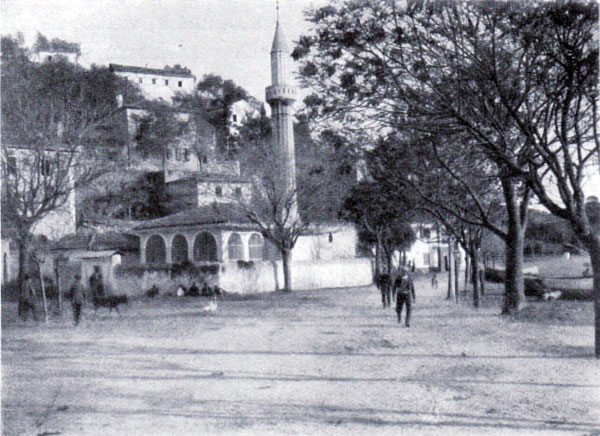
The rose-coloured (gülgun) fortress of Ülgün (Ulcinj), which is at the extreme frontier.
The name, meaning ..... in the ..... language, has become corrupted to Ülgün (Ulcinj). The fortress was built by the Spanish infidels and was the imperial grant of their chief cardinal. The Venetians later took it over by a ruse. In 883 (1478) they delivered its keys to Ahmed Pasha Hercegolli, the vizier of Mehmed the Conqueror, (30) and delivered themselves to the abodes of hell. Mehmed Khad in turn registered it as the imperial grant of the sandjak bey of Shkodra. It is now administered by a voyvoda and has a kadi with a salary level of 150 akçe.
The stone-built fortress is hexagonal in shape and is situated on ..... the coast of the Gulf of Venice. It is well-maintained and embellished with towers, ramparts, serrated battlements, embrasures, loopholes and moats, and is furnished with all major supplies. Inside are the mosque of Sultan Mehmed the Conqueror and ..... small houses for the garrison troops, all roofed with ..... . There are grain storehouses, armouries, water cisterns and huge long-range battering guns. The castle warden resides in a loggia in front of the gate and 700 Albanian ghazis stand guard along with the garrison troops, brave and doughty warriors all. Most of them are frigate-men. There are 20 frigates in the harbour, as the fortress is situated on the coast. The Albanians here and from other towns take to their frigates and plunder infidel territory, burning and destroying, then return to Ulcinj with rich booty and choice captives, and give one-tenth of the spoils to the sandjak bey. When I was there, 7 frigates had just returned from the infidel lands of Puglia, and Yusuf-Bey-oglu received a tenth of the spoils, amounting to 21,000 kuru?, as well as 17 slaves. With this money, he paid off the debt he owed to Melek Ahmed Pasha.
From here we returned to Shkodra and from there to the town of Bushat, where we spent one night as guests of the pasha. Yusuf-Bey-Zade gave me musk-scented Venetian gold coins amounting to 13,000 kurus to fulfil his obligations to Melek Ahmed Pasha. The transaction was recorded in a legal document, and I gave the bey an official receipt. He also gave me, as gifts for Melek Ahmed Pasha, 3 Frankish slave boys, 20 watches with gold casings, 1 set of pearl prayer-beads, 40 rolls of brocade, 40 rolls of Genoese velvet and 1 dagger with a jewelled coral handle. These, too, were registered in the letter for Melek Ahmed Pasha. To me he gave 300 Venetian gold coins, a Spanish slaveboy named Bihzad, a horse and a sword, and to each of my retinue and slaves he gave 10 gold coins and a length of cloth. He also furnished us some of his men as escorts.
The next day ..... Castles and stage posts which we toured journeying from Shkodra to Istanbul. .....
The 'House of Fish,' i.e., the fortress of Mut. (31)
The name is Albanian for ..... . It was built by the kings of Spain and in 883 (1478) was taken from the Venetian infidels by Mehmed the Conqueror. Administratively, it belongs to the sandjak of Shkodra and is the seat of a deputy kadi. Mut is situated on ..... on the banks of the Ishëm (32) river. It is an ancient stonework construction, square in shape and with four towers. Once a year, a great multitude of fish appears in the Ishëm river flowing below the fortress. Merchants salt these fish and export them to Europe. The fish are so delicious that some local Greek historians have dubbed this fortress 'House of Fish'. There was said to be a mighty fortress here in ancient times.
The fortress has a single gate facing towards the .....; a total of ..... little houses for the garrison soldiers, with roofs but without gardens; a mosque of Sultan Mehmed the Conqueror, grain storehouses; ammunition cellars; and a good number of brass muzzle-loading cannons. The warden is the ruler (hakim) of the fortress and the voyvoda is the commanding officer. There are about 200 men, all brave Albanian ghazis and very hospitable to strangers - whenever travellers appear, they host them royally in their homes. Goods are cheap and plentiful. Aside from the famous fish, there are vineyards, orchards and well-kept gardens. Because of the mild climate, the young boys and girls are very pretty. There is another fortress of Mut in the sandjak of Silifke in Anatolia. .....
From here we set off eastwards ..... and arrived at Yeni Kale ('New Fortress'). (33) It was built by Sultan Mehmed the Conqueror in 883 (1478). It is situated in the sandjak of Dukagjin in the eyalet of Rumelia, and has a suba?i and a deputy judge - there are no other magistrates. It is built of stone and lies at the foot of a mountain. Because it is situated well within Ottoman territory, it has fallen into ruins with the passing of time. Nevertheless, it has a warden and 10 garrison soldiers and a good number of brass muzzle-loading cannons. .....
From here, we set off and arrived at the village of Spas. (34) This also belongs to the sandjak of Dukagjin. It is a little town, with 1,000 houses, 1,000 select Albanian musketeers, one congregational mosque, one han and 5 or 10 shops. .....
Continuing on from here we arrived in Gjakova. (35) There is another Djakovo in the sandjak of Požega, but this Gjakova is in the sandjak of Dukagjin. It is a flourishing and attractive town consisting of 2,000 houses, all of stone with ..... roofs and gardens. It is ruled by a voyvoda and has a kadi with a salary level of 150 akçe. The public buildings are situated on a broad plain. They include two richly-adorned congregational mosques; several prayer-houses; some hans with leaden roofs, which at present are stocked with biscuits and munitions for the Kotor campaign; a delightful bathhouse; and about 300 shops like nightingale-nests. Because of the mild climate, the young boys are very pretty.
[Skopje]
As the last places referred to by Evliya on his way from Belgrade and Bosnia are Prijepolje and Mileševa in the sandjak of Novi Pazar, we may assume that substantial parts of the text are missing here. The Mat or Mati river flows to the sea between Tirana and Lezha. Ofrata (or Oqrasa?) is perhaps equivalent to Orosh. One may assume that here again substantial parts of the text are missing since Evliya does not mention the impressive fortress of Kruja which he must have visited, or at least seen, on his way from Tirana to Lezha. Possibly Mamurras which lies north of the Ishëm river and but 12 kilometers south of the Mati river. The Relazione di Mariano Bolizza of 1614 refers to the toponym Omuragni. Noticeable here is the lack of any reference to the Albanian national hero Scanderbeg (1405-1468) who was buried in the Church of St. Nicholas in Lezha and whose bones were said to have been used by Turkish soldiers as talismans. Shkodra or Shkodër is known in Turkish as Iskenderiyye, Iskodra or Üsküdar, in Italian as Scutari and in BCS as Skadar. Formerly Alexandretta, at the eastern end of the Mediterranean coastline of modern Turkey. This is Evliya's name for Lake Shkodra, based on the name of the Buna, formerly Bojana, river which flows out of it at the foot of the fortress of Shkodra. For Kevser, see Koran 108:1; for 'pure wine' see Koran 76:21. Ferhad is a figure in Persian and Turkish romance who performs tremendous feats with his pick. 634-644 A.D. Mod. Alb. për tynëzot 'for the Lord's sake'. Mod. Alb. falemi, burra 'greetings, men'. The greeting të falem is still used by elderly people in Albania. Mod. Alb. a je shëndosh, a mbaheni? 'Are you well, are you keeping up?' The second verb, in contrast to the first, is in the respectful plural ju form. One would normally expect either the familiar singular a je shëndosh, a mbahesh? or the respectful plural a jeni shëndosh, a mbaheni?
Mod. Alb. mirë ndeshtrasha 'greetings', i.e. mirë ndesh (ty) të rasha a greeting still used in Shkodra dialect. cf. ndeshtrashë n.f. 'unexpected occurrence, event, meeting'. Mod. Alb. mirë se erdhe 'welcome'. Possibly Mod. Alb. të falem shumë. Mod. Alb. pa eja, burra 'come on, men'. In Shkodra dialect, one often encounters the reduced form p'eja. Mod. Alb. elb ti ke? 'Do you have barley?' There does not seem do be any trace of an early *aki for standard elb 'barley'. Mod. Alb. nuk kam 'I haven't'. The negative form nuku, for standard nuk, now occurs primarily in the southern dialect of Korça. Unclear. Possibly Mod. Alb. *aki më bjerr, të ikën kryet, i.e. 'bring me aki, otherwise your head will be off'. Alb. për tynëzot nuk kam *aki 'In the name of our Lord, I have no *aki'. Mod. Alb. ha mut 'eat shit'. Mod. Alb. të qifsha tët amë 'I'll fuck your mother'. First person optative of the verb qij 'to fuck' plus accusative of jot amë. This expression, in the standard form të qifsha nënën, is one of the most commonly heard expletives in the Albanian language today. Mod. Alb. të qifsha tët shoqe 'I'll fuck your wife'. Mod. Alb. të pjerdhsha mbë hund 'I'll fart in (your) nose', an insult still known in Shkodra. First person optative of the intrans. verb pjerdh 'to fart' plus the Geg preposition mbë for standard në. Mod. Alb. të qifsha (në) bythë 'I'll fuck your ass'. Mod. Alb. i shkërdhyem, 'fucked'. Passive past participle of the verb shkërdhej 'to fuck' with the Geg ending -yem. A common insult in modern Albanian, especially in the Tirana dialect form shkërdhatë. Turkish Busatlar, is in fact 15 km. south of Shkodra. The name is actually Slavic and means 'at the foot of the hill'. Hersek-zade Ahmed Pasa actually became a vizier only in 894 (1489 A.D.), during the reign of Bayezid II, and grand vizier in 902 (1497 A.D.). Ottoman sources (1560-1574) also record the toponym as Mus or Musje, site of the Fortress of Ishëm. It was said to be located at the mouth of the Ishëm river near Kruja, (cf. Kornrumpf 1995, p.148). Evliya's spelling is perhaps influenced by the rhyme with hut 'fish' and the like-sounding town of Mut in Anatolia which he mentions below, or perhaps there is confusion with Mat (given that the mouths of the Ishëm and Mat rivers are very near to one another), or with Milot on the banks of the Mat. Babinger (1930, p. 56), implausably suggested an identification with the obscure settlement of Motri, referred to by Shkodra historian Marinus Barletius in his 1504 description of the siege of Shkodra, which Barletius says is 27 miles from Drivasto (Drisht). Turkish Esim. The Ishëm river, ancient Isamnus (Vibius Sequester 149), was recorded in 1302 as Yssamo and in 1622 as Isemi. If Evliya was travelling from here on to Spas and Gjakova, he must have departed up the valley of the Mat river, not the Ishëm. Unidentified. The settlements of Spas and Hani i Spasit, situated on the Drin riverhalf way between Fierza and Kukës, no longer exists, having been submerged with the damming of the river. In western Kosova, BCS Djakovica, Tk. Yakoviçse. [Extract from: Robert Dankoff and Robert Elsie (ed.): Evliya Çelebi in Albania and Adjacent Regions (Kosovo, Montenegro, Ohrid), Leiden 2000, p. 27-57. Translated from the Ottoman Turkish by Robert Elsie and Robert Dankoff.]
